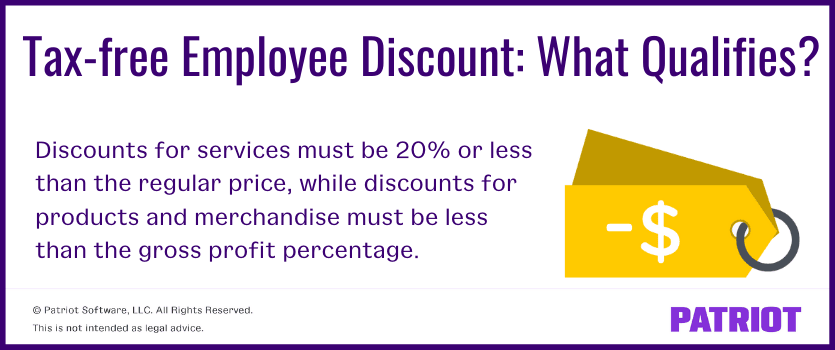Want to encourage employees to sport your company’s apparel? Or, looking for an employee benefit that’s appealing to new hires? You may consider offering employee discounts. Employee discount programs for small business come with several business benefits, like increased retention and sales. But before offering them, understand what qualifies as an employee discount and whether discounts are taxable income.
What are employee discounts?
Employee discounts are a type of fringe benefit that gives workers a special discount on company goods or services. Generally, the discount is a percentage off regular pricing. Employee discounts are common in retail stores like car dealerships, clothing stores, grocery stores, and bookstores.
For example, Barnes & Noble offers employees 50% off at the cafe and 30% off in the bookstore.
Offering employee discounts can help you:
- Attract and retain employees
- Boost sales
- Increase brand loyalty
- Increase employee engagement
Are employee discounts taxable?
Employee discounts may be tax-exempt depending on the type of company discount. To qualify as a tax-exempt employee discount, the discount must cover the goods and services you also offer customers.
For example, the coffee shop, Life’s a Grind, has a discount for employees on drinks, tumblers, and pastries. Life’s a Grind employee discounts may qualify as tax-free because the discounts cover items also sold to customers.
There are other requirements for tax-free employee discounts you should know about.
Tax-exempt employee discounts
Employee discount programs must meet specific requirements to be tax-free. There are two types of discounts to consider:
- Services
- Merchandise and other property

Employee discounts for services
Employee discounts on services are tax-free if they don’t exceed 20% of the price charged to customers. The price that determines the 20% limit can include a discounted price offered to select customers as long as that price is 35% or more of your gross sales for a period.
Let’s look at an example of this in action. The cleaning service, So Fresh So Clean, offers a 25% discount on services to school districts. For 2022, cleaning services for school districts made up more than 50% of So Fresh So Clean’s sales. Because of this, the price used to determine the 20% discount for employees changed to the discounted price offered to school districts.
If So Fresh So Clean charges a general rate of $75 an hour, the discounted rate for qualifying school districts is $56.25 (75 X 0.25). Because school districts make up more than 35% of gross sales for the year, So Fresh So Clean can base employee discounts on the school districts’ discounted price of $56.25. So Fresh So Clean calculates tax-free employee discounts of 20% from $56.25 for an employee discounted rate of $45 (56.25 X 0.20).
Employee discounts for merchandise or other property
Employee discounts on merchandise are tax-free if the discounts don’t exceed your gross profit percentage. Use this formula to find your gross profit percentage:
Gross Profit Percentage = (Total Cost of Goods Sold – Total Sales Price) / Total Sales Price
What does this look like in action? Let’s look at an example. The book company, Rose as Read Books, has a gross profit percentage of 30%. Rose as Read buys a book from the publisher for $13.30 and sells it for $19 [(13.30 X 0.30) / 13.30]. To qualify as tax-free, the discount for employees for books can’t be greater than 30%. If the employee discount exceeds 30%, it would no longer qualify as tax-free.
Taxable employee discounts
There are instances when you must report employee discounts as employee income. Report employee discounts as income if the discount is:
- Services: Greater than 20%
- Merchandise: More than your gross profit percentage
When reporting employee discounts as employee income, make sure to only report the dollar amount that exceeds tax-exempt employee discounts.
For example, the plumbing business, Royal Flush, offers its hydro jetting services to employees for $140 when customers pay $200. This is a 30% employee discount ($200 X 0.30 = $140). While 20% of the employee discount for services is tax-free, Royal Flush must add the additional 10% ($14) to the employee’s taxable income.
Who can receive qualified employee discounts?
Contrary to popular belief, employees aren’t the only ones that can receive employee discounts. The IRS refers to employee discounts as qualified employee discounts. But, what is a qualified employee?
Qualified employees can include:
- Current employees
- Retired or disabled former employees
- Widows or widowers of employees that passed away while still employed or during retirement
- The spouse or dependent child of an employee
- Partners that perform services if your business is a partnership
- Shareholders that perform services and own more than 2% stock if your business is an S corporation
Reporting employee discounts as taxable income
Again, employee discounts are taxable if they exceed the IRS limits. Discount amounts in excess of the IRS limits are subject to income, Social Security, Medicare, and FUTA taxes.
Add the excess value of the taxable employee discount to the employee’s regular wages for a payroll period (e.g., weekly, biweekly, monthly, etc.) and figure income tax on the total.
Withhold income and FICA taxes on the date or dates you treat the taxable employee benefits as paid (no later than Dec 13 of the calendar year). You must determine the value of taxable employee discounts before January 31 of the next year.
Report taxable employee discounts as wages on the correct tax form.
| Type of Employee | Return |
|---|---|
| Employee | Form W-2, Wage and Tax Statement |
| Independent contractor | Form 1099-NEC, Nonemployee Compensation |
| Partner | Schedule K-1 (Form 1065), Partner’s Share of Income, Deductions, Credits, etc. |
See IRS Publication 15 for more details.
A word on fringe benefits
Company discount programs are a form of fringe benefit, but they aren’t the only type of fringe benefit out there. A fringe benefit is an additional form of payment for the performance of services.
Fringe benefits are often offered in hiring packages and can include:
- Health insurance
- Life insurance plans
- Tuition assistance
- Childcare reimbursement
- Employee discounts
Keeping track of employee wages can be confusing, but it doesn’t have to be. Patriot’s online payroll software can help you easily input employee wages and make sure things are right the first time. Try it for free today!
This is not intended as legal advice; for more information, please click here.



